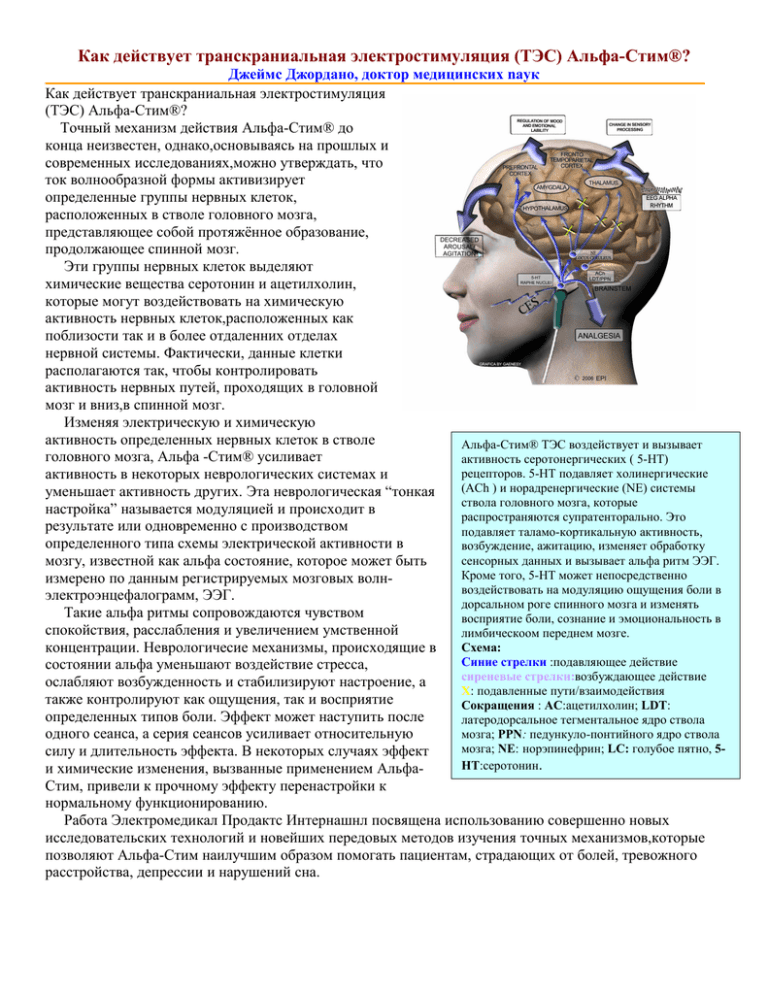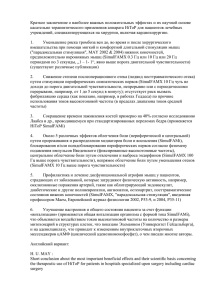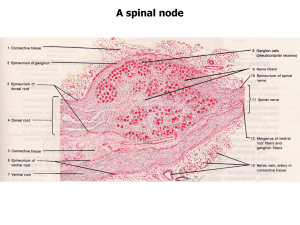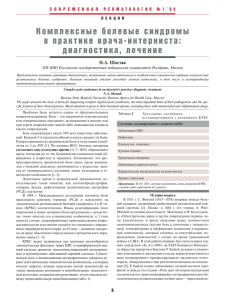(ТЭС) Альфа-Стим
advertisement

Как действует транскраниальная электростимуляция (ТЭС) Альфа-Стим®? Джеймс Джордано, доктор медицинских nаук Как действует транскраниальная электростимуляция (ТЭС) Альфа-Стим®? Точный механизм действия Альфа-Стим® до конца неизвестен, однако,основываясь на прошлых и современных исследованиях,можно утверждать, что ток волнообразной формы активизирует определенные группы нервных клеток, расположенных в стволе головного мозга, представляющее собой протяжённое образование, продолжающее спинной мозг. Эти группы нервных клеток выделяют химические вещества серотонин и ацетилхолин, которые могут воздействовать на химическую активность нервных клеток,расположенных как поблизости так и в более отдаленних отделах нервной системы. Фактически, данные клетки располагаются так, чтобы контролировать активность нервных путей, проходящих в головной мозг и вниз,в спинной мозг. Изменяя электрическую и химическую активность определенных нервных клеток в стволе Альфа-Стим® ТЭС воздействует и вызывает головного мозга, Альфа -Стим® усиливает активность серотонергических ( 5-НТ) рецепторов. 5-НТ подавляет холинергические активность в некоторых неврологических системах и (АСh ) и норадренергические (NE) системы уменьшает активность других. Этa неврологическaя “тонкая стволa головного мозга, которые настройка” называется модуляцией и происходит в распространяются супратенторально. Это результате или одновременно с производством подавляет таламо-кортикальную активность, определенного типа схемы электрической активности в возбуждение, ажитацию, изменяет обработку сенсорных данных и вызывает альфа ритм ЭЭГ. мозгу, известной как альфа состояние, которое может быть Кроме того, 5-НТ может непосредственно измерено по данным регистрируемых мозговых волнвоздействовать на модуляцию ощущения боли в электроэнцефалограмм, ЭЭГ. дорсальном роге спинного мозга и изменять Такие альфа ритмы сопровождаются чувством восприятие боли, сознание и эмоциональность в спокойствия, расслабления и увеличением умственной лимбическоом переднем мозге. Схема: концентрации. Неврологичесие механизмы, происходящие в Синие стрелки :подавляющее действие состоянии альфа уменьшают воздействие стресса, сиреневые стрелки:возбуждающее действие ослабляют возбужденность и стабилизируют настроение, а Х: подавленные пути/взаимодействия также контролируют как ощущения, так и восприятие Сокращения : АС:ацетилхолин; LDT: определенных типов боли. Эффект может наступить после латеродорсальное тегментальное ядро стволa одного сеанса, а серия сеансов усиливает относительную мозга; РРN: педункуло-понтийного ядро стволa мозга; NE: норэпинефрин; LC: голубое пятно, 5силу и длительность эффекта. В некоторых случаях эффект НТ:серотонин. и химические изменения, вызванные применением АльфаСтим, привели к прочному эффекту перенастройки к нормальному функционированию. Работа Электромедикал Продaктс Интернашнл посвящена использованию совершенно новых исследовательских технологий и новейших передовых методов изучения точных механизмов,которые позволяют Альфа-Стим наилучшим образом помогать пациентам, страдающих от болей, тревожного расстройства, депрессии и нарушений сна. How Alpha-Stim® Cranial Electrotherapy Stimulation (CES)Works James Giordano, PhD How does Alpha-Stim® Cranial Electrotherapy Stimulation (CES) work? The exact mechanism by which Alpha-Stim® produces effects is not fully known. However, based on previous and ongoing studies, it appears that the Alpha-Stim® micro current waveform activates particular groups of nerve cells that are located at the brainstem, a site at the base of the brain that sits atop of the spinal cord. These groups of nerve cells produce the chemicals serotonin and acetylcholine, which can affect the chemical activity of nerve cells that are both nearby and at more distant sites in the nervous system. In fact, these cells are situated to control the activity of nerve pathways that run up into the brain and that course down into the spinal cord. By changing the electrical and chemical activity of certain nerve cells in the brainstem, Alpha-Stim® appears to amplify activity in some neurological systems, and diminish activity in others. This neurological ‘fine tuning’ is called modulation, and occurs either as a result of, or together with the production of a certain type of electrical activity pattern in the brain known as an alpha state which can be measured on brain wave recordings (called electroencephalograms, abbreviated EEG). Such alpha rhythms are accompanied by feelings of calmness, relaxation and increased mental focus. The neurological mechanisms that are occurring during the alpha state appear to decrease stress-effects, reduce agitation and stabilize mood, and control both sensations and perceptions of particular types of pain. These effects can be produced after a single treatment, and repeated treatments have been shown to increase the relative strength and duration of these effects. In some cases, effects and chemical changes evoked by AlphaStim® have led to a durable re-tuning back to normal function. Electromedical Products International, Inc. is dedicated to using exciting new research technology and advanced, innovative methods to study the exact mechanisms through which Alpha-Stim® can be beneficial to patients with pain, anxiety, depression and sleep disorders. James Giordano, Ph.D. is a UNESCO Fellow and Scholar in Residence at the Center for Clinical Bioethics, Georgetown University Medical Center, Washington, DC. Dr. Giordano is also Visiting Scholar at the Center for Ethics, Dartmouth Medical School, Hanover, NH, and Invited Lecturer at the Roundtable in Arts and Sciences, Oxford University, UK. As a neuroscientist, Dr. Giordano`s ongoing work is focused upon neural mechanisms of pain, the philosophy of pain research and practice of pain medicine, and the neuroethical issues inherent to the development and use of emergent technologies in neurology and psychiatry. Dr. Giordano received his Ph.D. in biological psychology from the City University of New York. He was a NIEHS post-doctoral fellow in neurotoxicology and neuroscience at The Johns Hopkins University, Baltimore, MD, served as Visiting Scientist in the Department of Clinical Neuropharmacology, Max Planck Institute for Psychiatry, Munich, Germany, was an American Psychological Association Visiting Fellow in neuroimaging at the Martinos Center for Advanced Imaging, Harvard University Medical School/Massachusetts General Hospital, and completed post-graduate training in bioethics at the Neiswanger Institute for Bioethics and Health Policy, Loyola University/Stritch Medical School, Chicago, IL. The author of over 65 refereed publications on pain, ethics and medical philosophy, Dr. Giordano serves as Neuroscience Section Editor for the Pain Physician journal, Bioethics Editor for the American Journal of Pain Management, and Ethics .Section Editor for the journal Practical Pain Management


![УДК 616. 381 – 008.6 – 072.1 – 06] –... Р. М. ЯПАРОВ, А. Е. АЛБАКОВА, О.Ю. РЫБАЧЕК](http://s1.studylib.ru/store/data/002519553_1-d1b3216bd5e167b5580620d6b4f4fd36-300x300.png)

